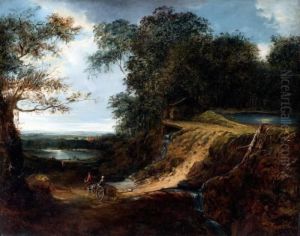Jacques D Artois Paintings
Jacques d'Artois, born in 1613 in Brussels, was a prominent figure in the Flemish Baroque painting movement of the 17th century. Though not as universally recognized as some of his contemporaries like Peter Paul Rubens or Anthony van Dyck, d'Artois carved out a niche for himself with his mastery in landscape painting. His works are distinguished by their meticulous attention to detail, vibrant portrayal of natural scenes, and the harmonious interplay between light and shadow, which was a hallmark of the Baroque style.
D'Artois was a pupil of Jan Mertens and later studied under the guidance of Jacques Fouquières, a renowned landscape painter of the time. This tutelage under Fouquières greatly influenced d'Artois's artistic direction, steering him towards the specialization in landscape art. He became particularly adept at depicting wooded landscapes, a theme that would dominate much of his oeuvre. His landscapes often featured dense forests, with meticulous renderings of trees, underbrush, and the play of light filtering through the foliage, imbuing his scenes with a sense of depth and realism.
Throughout his career, Jacques d'Artois enjoyed the patronage of the Habsburg rulers of the Spanish Netherlands, which provided him with commissions that were instrumental in establishing his reputation. He was also a member of the Guild of Saint Luke in Brussels, which was an acknowledgment of his standing in the artistic community. Despite the prominence of religious and historical subjects in Baroque art, d'Artois remained focused on landscapes, contributing to the genre's development and popularity in the Flemish region.
D'Artois's influence extended beyond his lifetime, with his works inspiring subsequent generations of landscape artists. He was part of a family of artists, and his legacy continued through his relatives who also became painters. Jacques d'Artois passed away in 1686 in Brussels. Today, his works are held in various collections and museums, offering a glimpse into the lush landscapes of 17th-century Flanders and preserving the legacy of a master whose contributions to the Baroque movement continue to be appreciated by art historians and enthusiasts alike.
